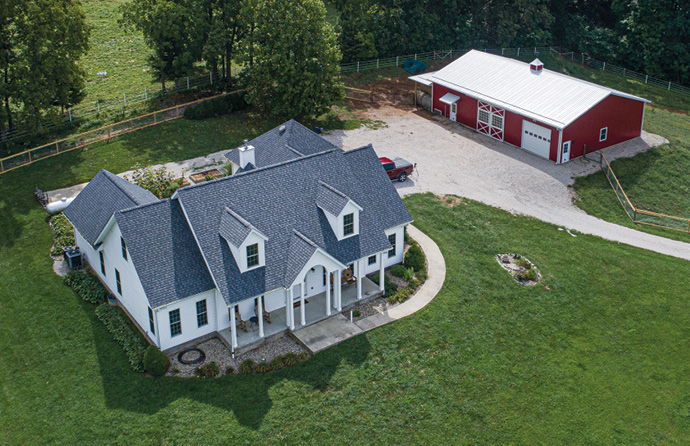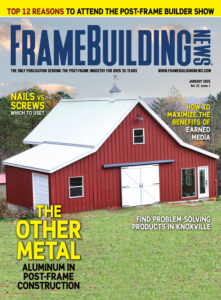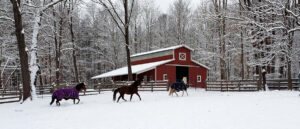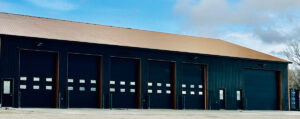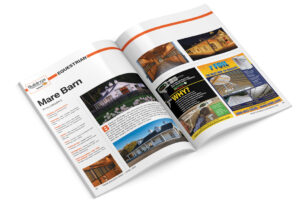Good air quality inside horse stables is important for not only maintaining the building, but also maintaining animal health. Damp air can damage framing and building components. Damage-causing condensation can drip down onto horses, feed and tack. Also, animal confines with inadequate air exchange promote the viability of disease-causing pathogens like bacterium, viruses and other microorganisms.
Horses create a lot of waste and moisture. Each day, the average horse produces about 50 pounds of manure and puts two gallons of moisture into the air. Since horses are herd animals and don’t do well by themselves, seldom does a horse-owner only have one horse. So, with each added horse, add another two gallons of humidity and 50 pounds of manure. Add in sweat and urine, plus moisture added during bathing and facility cleaning, and it’s easy to see why an improperly ventilated horse barn and the animals that live within may suffer. (Granted, stalls should be kept clean, but the horses’ “contributions” are a major factor in making adequate air exchange a necessity.)
A ventilation system isn’t a one-size-fits- all proposition. The amount of air exchange needed depends on how many animals will be housed and other factors, but a general rule is there should be six to eight air changes per hour. According to the Ontario Ministry of Agriculture, Food and Rural Affairs, in winter, a ventilation rate of 25-40 cubic feet per minute (cfm) per horse housed is ideal. In summer, ventilation rates as high as 300 cfm per horse are needed to keep air temperatures from rising within the barn.
Balance is Essential
While volumes may differ from building to building, the intake and exhaust in any building should be balanced. That is, the amount of air entering the building through the ventilation system and the amount of air exiting should be equal.
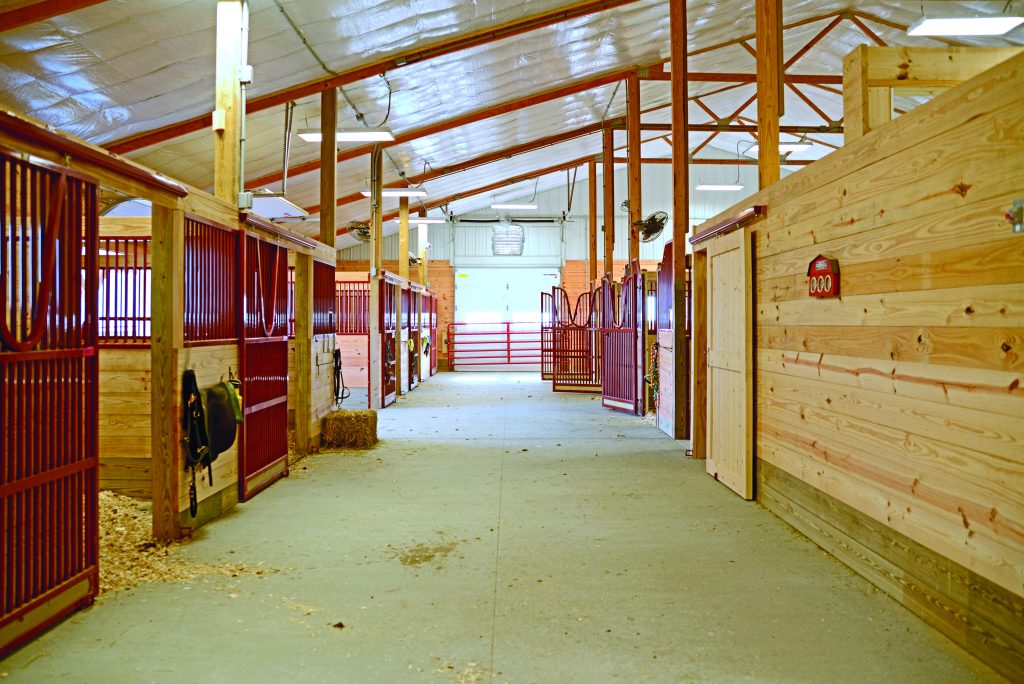
“Achieving the ideal intake and exhaust balance is crucial to a horse’s health,” explains Shannon Clark, Marketing Coordinator, MWI Components. “In fact, you could be causing serious health issues if the ventilation system is not properly balanced. A barn that is poorly ventilated will trap dust, dirt and other impurities in the building.”
To equally distribute fresh air along both sides of the stall barn, eave vents should run along the entire length of the sidewall. It’s imperative that the net free area (NFA) of the exhaust matches the NFA of the inlets. For example, if the ventilation system is comprised of eave vents and a ridge vent, the sum of the NFA of both eave vents should equal the NFA of the ridge vent. “The greatest flow per unit area of total opening is obtained by using inlet and outlet openings of nearly equal areas,” says Alicia Cahill, MWI’s Customer Service Manager. “If there is a difference in size, the lower opening should be slightly larger.”
The two types of ventilation systems used in post-frame construction are natural (aka passive) ventilation and mechanical ventilation.
Natural Ventilation
A natural ventilation system powered by temperature differences between the inside and outside air and local wind. As warm, moist air rises inside the building (convection) and exits through the ridge vent, it creates a negative pressure that draws cooler air with lower humidity in through the vents at the eaves. Wind hitting the roof can also help the venting process by creating low pressure (aspiration), which further draws out the warm air through the ridge vent and functioning cupolas. Selecting a building location that takes advantage of breezes will also help with the ventilation process.
If the ridge vent runs along the entire length of the roof, it will allow the maximum amount of contaminated air to escape. Incorporate a vented closure at the ridge to prevent dirt, debris, and wind-driven rain from finding its way into the stable at the ridge. Open-celled foam closures at the eaves will allow air to flow into the building while keeping out dirt, debris, and pests.
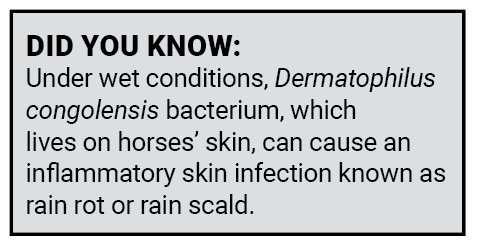
There is limited control in natural ventilation systems; the exchange of fresh air for foul is at the mercy of the elements. But during warm weather, opening doors and windows at opposite ends of the building will help move air through the stable; install windows and doors that will perform without failing.
“Two openings on opposite sides of a space will tend to increase the ventilation flow; this is why Bale or Dutch Doors should be considered as an inlet,” says Clark. “These allow through ventilation into a building and provide circulation in and out of enclosed stalls.”
“Opening a door on each end of the alley may not be enough, though,” adds Cahill. “Systems using natural ventilation should be designed for effective ventilation regardless of wind direction. There must be adequate ventilation when the wind does not come from the prevailing direction. This is also where a multi-purpose option, such as a Dutch Door, is desirable as it allows greater flexibility when bringing fresh air into the space and gives greater flexibility to what level or direction it is introduced.”
During cold weather, windows and doors are kept closed to keep cold drafts off the horses. When it’s cold outside, the main goal of the ventilation system is to control odor, moisture, and ammonia buildup. Vents running along the length of the sidewalls provide a continuous supply of fresh air that allows the contaminated, moist air to escape through the ridge vent … that is, if the moisture makes it to the ridge.
Condensation
When warm, moist air rises, if conditions are favorable, the moisture condenses on the underside of an uninsulated metal roof. When there’s so much condensation that the surface tension can no longer hold it, droplets of water fall on whatever lies below. To prevent “rain” from falling inside an uninsulated barn, a condensation control system such as DripStop, applied on the underside of the roof panels, will hold the moisture until it can evaporate back into the air.

Mechanical Ventilation System
There are some cases where a natural ventilation system may not be enough to meet the fresh-air needs. For example, if the building is expected to have excessive moisture, a mechanical ventilation system would be a better choice. Even with a drain, bathing horses in a wash stall adds a lot of moisture to the environment. Water will be absorbed into the concrete, which is porous, to later end up in the air.
If the building has a new concrete floor, moisture is released into the air throughout the curing process. Depending on humidity levels and temperature, the curing process can take up to two months of drying time per inch of concrete pad.
When considering the overall design of the project, mechanical ventilation systems require the building to be well sealed. Insulation will prevent condensation and will keep the building cooler during the summer and warmer during the winter. Properly designed and operating mechanically ventilated stables have a slight negative pressure, which draws in fresh air through the inlets. The system may include powered fans mounted in a gable wall with opening and closing shutters on the opposite wall or under a covered vent in the roof. If a thermostat or hygrostat (which monitors humidity levels) are incorporated, they can turn on the system when needed. Power-vented cupolas are another option. Electric fans, triggered by temperature or humidity, can be mounted in the cupolas to mechanically exhaust as needed.
Barns with mechanical ventilation systems can be kept closed during the summer; running exhaust fans and inlets will keep the temperature from rising. Evenly distributed air inlets help with fresh air circulation and help with keeping the horses healthy and comfortable.
Distribution
Fans can also be used to evenly distribute fresh air throughout the building. They can be mounted on or above stalls to keep the horses cool and keep flies at bay. Additionally, fans can be mounted high on walls, or large, industrial-type fans can be mounted on the ceiling or on the bottom chord of a truss to continually distribute fresh air.
Grills in stall walls and doors can also play a role in animal comfort. “Grills will naturally enhance air circulation in a horse barn,” explains Clark. “But this will not be a ‘quick fix’ for misguided ventilation systems. Circulation of clean air — generated by an exceptional building ventilation system — through stall grills is the target to aim for.”
Conclusion
To maintain optimum air quality, a stall barn must have a ventilation system that will eliminate excess moisture, heat, odors, and ammonia and provide horses with fresh, clean air. Work out ventilation system specifics during the planning stage of your builds so your customer can give their horses the healthy home they deserve. FBN






